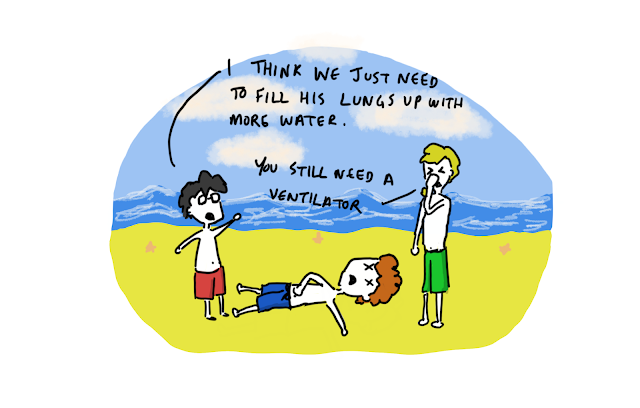With any luck, in your life you will get somewhere in the neighbourhood of 672,768,000 breaths. Most of those will be pretty run-of-the-mill in terms of their ingredients: 78% nitrogen, 21% oxygen, and 1% argon. Occasionally you might mix it up if you end up in the hospital, go to space or hit up one of those weird oxygen bar things. You might even breathe in something nasty like cigarette smoke either on purpose (why?) or by accident. The one thing all these breaths will have in common is that they are composed of gas, but what if I told you they didn’t have to be?
Solids are pretty much off the table. As interesting as it might be to try and suck oxygen from rocks, breathing gravel presents some logistical problems. Liquid, on the other hand, might not be as ridiculous as you think. Just ask a fish.
Although fish have the notable advantage of having gills, which pull oxygen from water and let carbon dioxide be dissolved away, there is surprisingly little standing in the way of you, me, or any other mammal getting by on liquid breaths. All you really need is a liquid that can deliver a lot of oxygen, which unfortunately disqualifies water. Although H2O is largely made out of it, water typically only contains about 1% dissolved oxygen. That is part of the reason aquatic life is so sensitive to disruptions in available oxygen.
No, what we need is something that really packs the O2 punch and there are two promising candidates, that we know of: silicone oils and perfluorocarbons (PFCs). Silicone oils, as it turns out, are toxic so we can put those in the reject bin with the water, PFCs though have some cool possibilities.
PFCs were first sythesized as part of the Manhattan Project (what weren’t those guys working on?) and are made up entirely of carbon and fluorine. For various chemical reasons that we won’t get into here, that means PFCs can dissolve up to 20 times more oxygen than water can, which is music to a lung’s nonexistent ears.
Now, this is all great in theory, but no one would actually test this, would they? Actually, if you’ve ever watched the James Cameron movie The Abyss, you’ve seen an actual mammal breathe actual liquid. In this scene, no special effects were used. Wild, right?
So why aren’t we all living in PFC filled bubble cities at the bottom of the ocean? Well, even if we could overcome the sheer terror it would be to breathe liquid for the first time, it turns out that while PFCs might be the perfect liquid-breathing medium, lungs are not the perfect liquid-breathing machines. Lungs evolved to inhale and exhale light, gaunty air and PFCs are more than twice as dense as already not-super-light water. In order to exhale enough PFCs to not overload your system with carbon dioxide, your lungs would have to be able to move 12 kg (over 26 lbs) of fluid in a single breath.
Let’s step back for a minute and ask the fairly obvious question: why would anyone actually want to breathe a liquid? The thing about liquids is that they are really hard to compress, much harder than gases, anyway. One of the biggest things holding back scuba divers from going to truly crazy depths to explore, or work on oil rigs or whatever else they want to get up to down there is the fact that the deeper you go, the higher the pressure. As the weight of all the water above you pushes in from all directions, the air pockets in your body (the biggest of which are your lungs) just want to implode. Fill those pockets with liquid to stop the compression and the sky's the limit… Or the Mariana Trench is the limit, I guess.
Since the promise of money from oil will drive people to suggest seemingly insane things, it has been proposed that divers could wear a special vest to mechanically constrict their chests and help them exhale harder along with having a catheter inserted into their femoral arteries to act as a kind of artificial gill and scrub away CO2. As you can imagine, divers aren’t lining up to give that a try, though.
But even if we can’t use liquid breathing to have fun underwater adventures like in The Abyss there may still be a use for it. Researchers with more noble intentions than oil prospectors have conducted a number of studies looking at how liquid-breathing could be used as a therapy for patients with respiratory issues when used with a ventilator. In premature infants born with underdeveloped lungs, liquid ventilation has been shown to have some benefits. One study from way back in 1996 took thirteen premature babies who were not expected to survive after more conventional treatments failed and demonstrated that with short sessions of liquid-breathing to help them along, eight were able to survive. Not too shabby. Similarly promising results have been demonstrated in studies on adult patients with acute respiratory syndrome (1994, 2011).
The mechanism of the benefits has to do with surface tension in the lungs. Essentially where air meets liquid in a person’s lungs, sometimes the surface tension in the liquid can be so strong that it doesn’t allow oxygen to move into that liquid efficiently. When you fill those lungs with liquid, you can negate that problem and, with the help of a ventilator, you can pump out the carbon dioxide that would otherwise build up. That buys the patient some time in which their body can heal (or adapt to a gas environment in the case of brand new babies).
That is all great and extremely cool, just don’t tell any oil executives about it.









